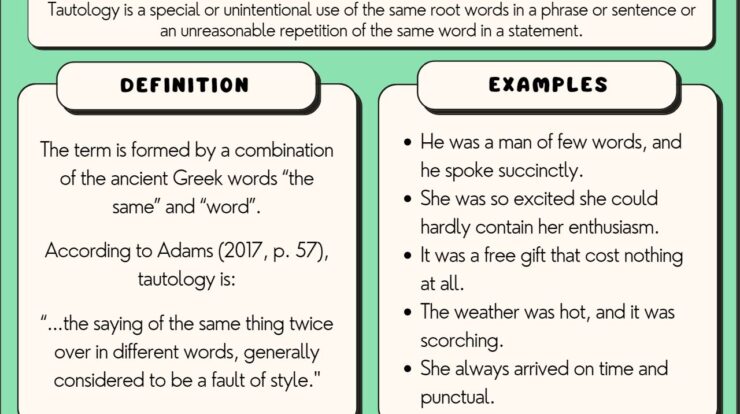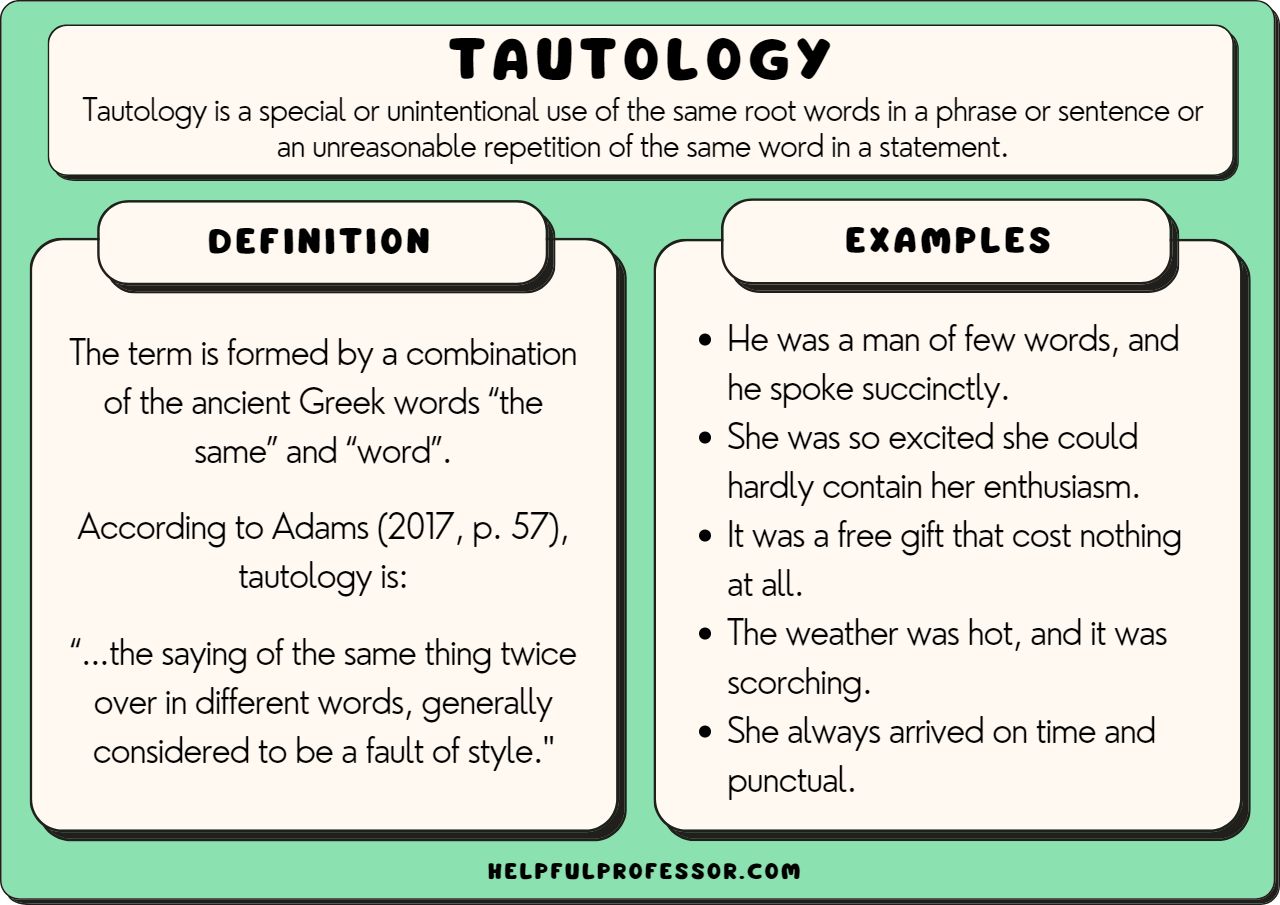
Tautological definitions, a fundamental concept in communication, offer a unique approach to defining terms by using circular reasoning. This intriguing linguistic tool has sparked discussions about its purpose, types, and ethical considerations, making it a captivating subject for exploration.
As we delve into the world of tautological definitions, we will uncover their diverse applications, ranging from law and science to everyday conversations. Join us on this journey to unravel the complexities of tautologies and their impact on our understanding of language and communication.
Introduction to Tautological Definitions

A tautological definition is a type of definition that restates the meaning of a term using different words or phrases. It does not provide any new information or clarify the concept, but rather simply repeats the same idea in a different form.
For example, the tautological definition of “bachelor” is “an unmarried man.” This definition does not provide any new information about the concept of “bachelor,” but rather simply restates the same idea in a different way.
Tautological definitions can be useful in some contexts, such as when they are used to clarify the meaning of a term for a specific audience. For example, a teacher may use a tautological definition to explain the meaning of a new term to a class of students.
Types of Tautological Definitions
There are two main types of tautological definitions:
- Verbal definitionsrestate the meaning of a term using different words or phrases.
- Circular definitionsdefine a term using the term itself, or a synonym of the term.
Verbal definitions are the most common type of tautological definition. For example, the verbal definition of “dog” is “a four-legged mammal that barks.” This definition restates the meaning of “dog” using different words and phrases.
Circular definitions are less common, but they can be useful in some contexts. For example, the circular definition of “God” is “the supreme being.” This definition defines “God” using the term itself, which can be helpful for understanding the concept of God in a religious context.
Tautological Definitions in Communication
Tautological definitions can be used in communication to clarify or obscure meaning. When used to clarify meaning, tautological definitions can help to ensure that both the speaker and the listener are using the same terms in the same way.
For example, if a speaker is talking about the concept of “justice,” they may use a tautological definition to ensure that everyone in the audience understands what they mean by “justice.” This could help to prevent misunderstandings and ensure that everyone is on the same page.
However, tautological definitions can also be used to obscure meaning. By restating the same idea in a different way, a speaker can make it more difficult for the listener to understand what they are really saying.
For example, a politician may use a tautological definition to avoid answering a question directly. This can be a way of avoiding accountability and making it more difficult for the public to understand their true intentions.
Ethical Considerations of Tautological Definitions
There are a number of ethical considerations that should be taken into account when using tautological definitions. First, it is important to be aware of the potential for misuse and misinterpretation. Tautological definitions can be used to deceive or mislead people, and it is important to be aware of this potential.
Second, it is important to use tautological definitions responsibly. Tautological definitions should not be used to avoid answering questions or to obscure meaning. They should only be used to clarify meaning and to ensure that everyone is using the same terms in the same way.
Applications of Tautological Definitions
Tautological definitions have a number of applications in various fields. In law, tautological definitions are used to define legal terms and concepts. For example, the tautological definition of “murder” is “the unlawful killing of one human being by another.” This definition restates the meaning of “murder” using different words and phrases, but it does not provide any new information.
In science, tautological definitions are used to define scientific terms and concepts. For example, the tautological definition of “energy” is “the ability to do work.” This definition restates the meaning of “energy” using different words and phrases, but it does not provide any new information.
Tautological definitions can also be used in other fields, such as philosophy, mathematics, and economics. They can be a useful tool for clarifying meaning and ensuring that everyone is using the same terms in the same way.
Conclusive Thoughts

In conclusion, tautological definitions present a multifaceted tool in communication, capable of both clarifying and obscuring meaning. Their ethical use requires careful consideration to avoid misuse and misinterpretation. Understanding the different types and applications of tautological definitions empowers us to harness their potential effectively.
Whether in legal documents, scientific discourse, or casual conversations, tautologies continue to shape our understanding of language and the world around us.
Question Bank
What is the primary purpose of a tautological definition?
Tautological definitions aim to clarify the meaning of a term by restating it in different words, essentially defining a term using itself.
Can tautological definitions be misleading?
Yes, tautological definitions can be misleading if they are used to disguise a lack of understanding or to avoid providing a clear explanation.
What are some ethical considerations when using tautological definitions?
When using tautological definitions, it is essential to avoid circular reasoning, ensure accuracy, and consider the potential for misinterpretation.





